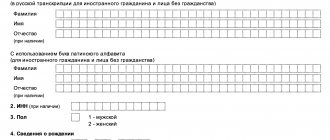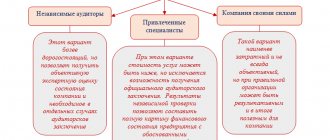What is a ledger, checklist
Among the variety of journals on business transactions, accounting, statements, reports and other documents required to be filled out at an enterprise, there is also a general ledger of accounting - this is the Ledger.
Translated from German it means “Big” or “Main Book”. It is a journal that contains the main summary data for all accounting reports and statements. In other words, the ledger is the main systematic register of synthetic accounting.
The golden rule of accounting - nothing comes from nowhere and nothing disappears into nowhere - is reflected in business transactions. Until the recent past, all accounting was done manually.
Many magazines contained information about the movement of funds, materials, personnel and absolutely everything that happened at the enterprise in value terms and in processes.
Nowadays, accounting records and reports, as well as some journals on operations, exist in electronic form in the 1C program - production, accounting, warehouse. But many more experienced accountants still duplicate information in writing. The “general ledger” of accounting is also in “1-C accounting”.
A huge number of software allows you to display data in the “General Ledger” and generate it automatically.
You can find out how to correctly fill out the General Ledger in 1C Enterprise here:
How to keep a book of income and expenses of an individual entrepreneur
The procedure for maintaining a book of income and expenses for individual entrepreneurs is no different from the general rules.
Entrepreneurs do not indicate in column 4 of Section I of the book income that is subject to personal income tax. This is directly stated in clause 2.4 of the Procedure approved by Order No. 135n.
In section IV of individual entrepreneurs on the simplified tax system, 6% without employees reflect the insurance premiums they transferred for themselves. Those who make payments to other individuals, in this column reflect both contributions transferred for themselves in a fixed amount, and similar payments paid for employees.
What and how is entered into the General Ledger register
Information about the financial position of the organization is reflected in the ledger. Business transactions and monetary amounts for them, before filling out analytical statements, are entered into the “Book” only if all operations were carried out correctly in the primary documents.
The sheets of the Ledger are filed and numbered. The number of sheets is certified by the seal and signatures of the head and chief accountant of the organization. This is done with all books and journals of strict accountability.
A special feature of the “General Ledger” is the checkerboard arrangement of accounts, which allows each column to reflect one corresponding account. This allows you to control the correctness of the corresponding accounts.
In the Ledger, transactions are recorded in both debit and credit, but the balance is not displayed. The turnover sheet is compiled on the basis of the General Ledger data.
Two statements - for cash and for wages (payroll sheet) serve as a source of basic data for the control sheet. Mandatory filling out of the cash register in large organizations is carried out every day, in smaller organizations - once every three to five days. After this, the summarized data is entered into the Ledger.
Transactions registered in the “general ledger” have their own serial number, which is recorded on the primary document. This allows you to quickly and easily find the information you need.
The ledger is filled out by the chief accountant or an approved employee. The manager endorses. Responsibility for the integrity and condition of the “General Ledger” lies with the chief accountant, responsible accountant and head of the organization.
Proofreading, retouching and corrections are highly unacceptable on a checklist. Therefore, the Ledger is filled out slowly and on the basis of data checked for accuracy. You can find out what responsibility the chief accountant of an enterprise bears in this article.
The “General Ledger” is stored, in accordance with Order of the Ministry of Culture of Russia dated August 25, 2010 No. 558, registered with the Ministry of Justice of Russia on September 8, 2010 No. 18380, for 5 years. The dates were approved by the Federal Archive on September 6, 2000.
Concept and characteristics of the General Ledger.
Rules for maintaining the “General Ledger”
The book opens for one year. The first data should be records of fund balances at the beginning of the reporting period. If the company has just been founded, then the ledger begins with reflecting the initial funds for operations.
Each numbered and bound sheet contains records of transactions for one account. The order of recording accounts is carried out in the order specified in the “Chart of Accounts”.
The title page contains the title, number of pages, date of creation, approval of the manager, seal, signatures of the manager, chief accountant and the person responsible for maintaining the control sheet.
Sample of filling out the General Ledger.
Since the “General Ledger” contains information about the movement of all business transactions - income and expenses, everything that the organization buys and sells, what amounts it receives and gives out loans, etc., the financial condition of the company can be determined from the data.
What information is contained in the document
The General Ledger sheet looks like this:
- at the top of the page there is the inscription “General Ledger”;
- Below is the reporting period - month, year (for example, September 2017);
- further – the name of the company, its division, budget, as well as the currency in which records are kept;
- to the left of the above data is a plate with the date, forms according to OKUD, OKPO, OKEY;
- Below, across the entire width of the sheet, is a table with 13 columns, lined into rows. The number of lines is limited only by the width of the sheet;
- in the first column is the serial number of the operation;
- in the second - the account number, then 3-4 - debit and credit at the beginning of the year;
- 5-6 columns – debit, credit at the beginning of the period (in this case for September), 7-8 columns – turnover for the period (debit, credit during September);
- 9-10 – turnover since the beginning of the year (debit, credit) – total data for the past 8 months is entered;
- Columns 11-12 – balance at the end of the period (debit, credit);
- the last, 13th column reflects the number of the business transactions journal;
- Under the table are the signatures and transcripts of the signatures of the chief accountant and those responsible for maintaining the control sheet, as well as the date.
Based on the results of debit and credit calculations for each reporting period, the amounts should be identical. For example, the sum of column 3 = the sum of column 4, and the sum of column 7 = the sum of column 8, and so on.
Ledger form to fill out.
Sample of filling out the General Ledger.
How to create a General Ledger in 1C 8.3
Open the General Ledger (Reports - General Ledger).
Please indicate:
- Period— period of report generation;
- Organization— the organization for which the report is being compiled.
The report will be generated based on accounting data by clicking the Generate .
Click the Show settings to configure the desired report format for yourself. Let's take a closer look at how to do this.
Setting up data grouping
On the Grouping you can set:
- output of data on subaccounts and subaccounts of corresponding accounts;
- frequency of report generation.
If the By subaccounts and By subaccounts of correspondent accounts , the information in the report will be displayed in the following form:
If the frequency is set, for example, “By months” , the data in the report will be generated broken down by the selected period:
Setting up an expanded balance
You can display the expanded balance in the report:
- by account;
- by subaccounts;
- according to subconto.
To do this, on the Expanded balance , select the appropriate checkboxes.
The report for the selected account displayed detailed information on the debit and credit balances:
Setting up report design
To ensure that the report meets the legal requirements for the design of accounting registers, go to Show settings and on the Design , select the following checkboxes:
- Heading,
- Signatures;
- Unit.
To print data for each account (subaccount) on a separate sheet, check the Split into sheets .
Saving report settings
The report settings can be saved.
Click the Show settings to open the report settings. Save settings button Saving report settings form , specify a name for the new setting and click the Save .
Period field when saving the settings , then the next time you select the General Ledger , it will be generated for the same “old” period.
To avoid errors, we recommend saving the report settings without the Period .
You can open saved settings by clicking the Select settings from the report settings form.
How to fill out sections of the income and expense ledger
Each business transaction performed by a taxpayer using the simplified tax system during the tax period, which has an impact on the formation of the tax base, must be registered in the book. Entries are made in chronological order. Based on the results of each quarter and at the end of the year, results are compiled.
ConsultantPlus experts provided a detailed commentary on filling out the book of income and expenses, including samples of completion. Get trial online access to K+ for free and proceed to recommendations.
Column 4 of Section I reflects income, the list of which is contained in Art. 249–250 Tax Code of the Russian Federation. Accordingly, the operations listed in Art. 251 of the Tax Code of the Russian Federation, as well as those that are subject to income tax for legal entities or personal income tax for individual entrepreneurs. Income received in kind is reflected at the market price of the received property.
Taxpayers who have chosen the accounting object “income minus expenses” enter their expenses in column 5 of the same section (their list is specified in Article 346.16 of the Tax Code of the Russian Federation). “Simplified people” who pay tax on the object “income” indicate in this column their expenses incurred as part of the implementation of budget unemployment programs, as well as expenses that were made from funds subsidized for the development of entrepreneurship.
Section II, concerning fixed assets, is filled out by simplifiers who have chosen “income minus expenses” as the object of taxation. Section III is also completed by taxpayers working with the “income minus expenses” object, if they have losses based on the results of previous years that can be taken into account when calculating the tax for the current year.
Section IV is filled out by taxpayers who calculate the single tax on the “income” object. All insurance premiums paid are recorded here, which have an impact on reducing the amount of accrued tax.
Since 2022, the book of income and expenses has been supplemented with Section V, in which taxpayers who have chosen “income” as the object of taxation reflect the amounts of trade duty paid, which affect the amount of tax payable to the budget.
For more information about the differences in the procedure for filling out the book, depending on the chosen object of taxation, read the material “The procedure for filling out KUDiR under the simplified tax system, income minus expenses .
You can download the current book of expenses and income form for 2021-2022 on our website using the link below:
If you use the tax object “income”, then see the sample KUDiR for 2022 in ConsultantPlus. If you have “income minus expenses,” then a sample for 2022 can be found at this link. It's free.
And if you need the previous version of the register (for 2013-2017), then this is it:
Procedure for filling out the General Ledger
This book contains reporting documents, their names, numbers of all accounts, including the cash register. Then fill in the amounts for the calculations carried out by the company for the period of the financial statements. The next part of the work is calculating the total amount of debit and credit, the data is entered into the necessary columns of the ledger, their correctness is checked by numbers, including checking the filling out forms.
All these instructions must be approved by management, who need to know how to properly maintain documents.
The general ledger must be prepared according to the instructions.
The procedure for creating transaction logs and the general ledger
The data of the primary accounting documents verified and accepted for accounting are systematized by the dates of transactions (in chronological order) and reflected in a cumulative manner in the following accounting registers.
The journal of transactions on the "Cash" account is used to record the movement of funds in the institution's cash desk. Entries in the specified register are made daily based on the cashier's report.
The journal of transactions with non-cash funds is a register for recording the movement of funds in the personal account of a budgetary institution.
In the Journal of Transactions of Payments with Accountable Persons, accounting is kept in a linear manner for each accountable person in the amount of the advance issued, the expense incurred, and the balance of the unused advance deposited at the cash desk. Entries in this register are made on the basis of advance reports.
A journal of settlements with suppliers and contractors is formed for each agreement with suppliers and contractors and is intended for analytical accounting of settlements made with them in combination with synthetic accounting. The register is maintained on the basis of invoices, waybills for receipt of material assets, invoices for payment for work performed, services provided, acceptance certificates for work performed and services provided for each supplier and contractor.
The journal of transactions with debtors for income is used to record transactions for accrual of income.
The journal of wage settlement transactions is compiled on the basis of consolidated payroll statements with primary documents attached to them (working time sheets, orders of the manager, etc.).
The journal of transactions on disposal and transfer of non-financial assets is used for deregistration and intra-company movement of fixed assets, intangible assets, and to account for the amounts of depreciation accrued for the reporting period. Accounting entries in this register are compiled on the basis of the relevant acts on the write-off of non-financial assets and the amount of depreciation accumulated as of the date of write-off, reflected in the inventory cards.
The Authorization Journal reflects not only the amounts of all concluded agreements of the institution, placed in accordance with the norms of the Federal Law of 04/05/2013 No. 44-FZ “On the contract system of procurement of goods, works, services for state and municipal needs” (hereinafter referred to as Law No. 44-FZ ) and concluded through public procurement, but also data from the Financial and Economic Activity Plan, estimates of income and expenses from other income-generating activities.
The Journal for Other Operations takes into account financial and economic transactions that are not reflected in other journals.
All Transaction Logs have the same form. In order to make it clear in the General Ledger from which Journal of Operations the indicators are entered, each of them is assigned a serial number, which should be reflected in the order of the institution “On Accounting Policy”. The transaction logs must be signed by the chief accountant of the institution, as well as by the executor who compiled this transaction log, indicating the position.
Monthly turnover on accounts from the Operations Journals is recorded in the General Ledger in the following sequence:
- 1) all turnovers from the Journal of transactions with non-cash funds are transferred to the General Ledger;
- 2) all transactions are transferred from the Journal of Operations on the Cash Account to the General Ledger. The exception is the receipt of cash from a personal account to the cash desk of the institution and the deposit of cash from the cash desk of the institution to the personal account;
- 3) from the Journal of transactions of settlements with accountable persons, the turnover on the issuance and return of accountable amounts reflected in the Journal of transactions on the “Cash” account is not transferred to the General Ledger;
- 4) those turnovers that do not include payment transactions reflected in the corresponding Transaction Journals are transferred from the Journal of settlements with suppliers and contractors;
- 5) from the Journal of transactions of settlements with debtors for income, turnovers are transferred, including operations for the accrual of income by administrators of budget revenues on the basis of primary documents on the accrual and receipt of income, settlements provided by the body providing cash services for budget execution;
- 6) all turnovers are transferred from the Journal of wage settlement transactions, with the exception of transactions with non-cash and cash funds;
- 7) from the Journal of transactions on disposal and transfer of non-financial assets and the Journal of other transactions, turnovers that were not transferred to it from previous Journals of operations are transferred to the General Ledger.
The correctness of the reflection in the General Ledger of turnover from the Operations Journals is checked as follows:
- – the sum of the debit balances of all accounts at the beginning of the corresponding period must be equal to the sum of the credit balances of all accounts at the beginning of this period;
- – the sum of the debit turnover of all accounts for the corresponding period must be equal to the sum of the credit turnover of all accounts.
Why do you need an extract from the balance sheet?
What kind of explanations and extracts accountants have to compile in the course of their work!
Some of them must be designed according to strictly established standards, others - in any form. One of these “arbitrary” documents is an extract from the balance sheet. There is no specific form for it - each statement is unique and depends on what information and in what volume the user requires.
Let us dwell on the most common situation when an extract from the balance sheet is needed in connection with the company’s decision to exercise the right not to pay VAT (Article 145 of the Tax Code of the Russian Federation).
NOTE! This right is granted by paragraph 1 of Art. 145 of the Tax Code of the Russian Federation for those whose revenue excluding VAT for the previous 3 months in a row did not exceed 2,000,000 rubles.
To be exempt from VAT under Art. 145 of the Tax Code of the Russian Federation, an extract from the sales book will also be required. Recommendations and a sample from ConsultantPlus experts will help you complete it. Get trial access to the system for free and go to the Ready-made solution.
About how to obtain exemption under Art. 145 of the Tax Code of the Russian Federation, read this material .










